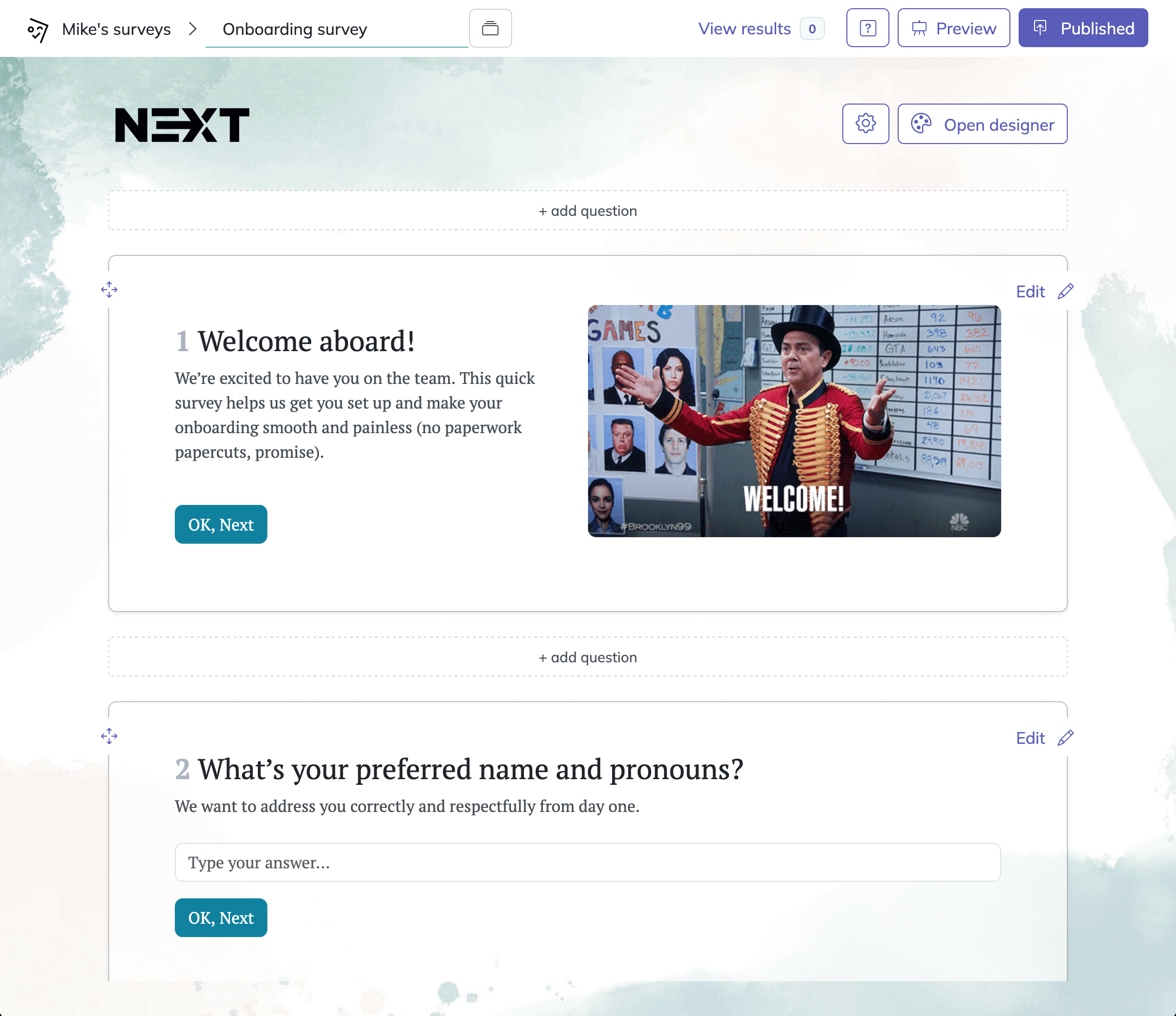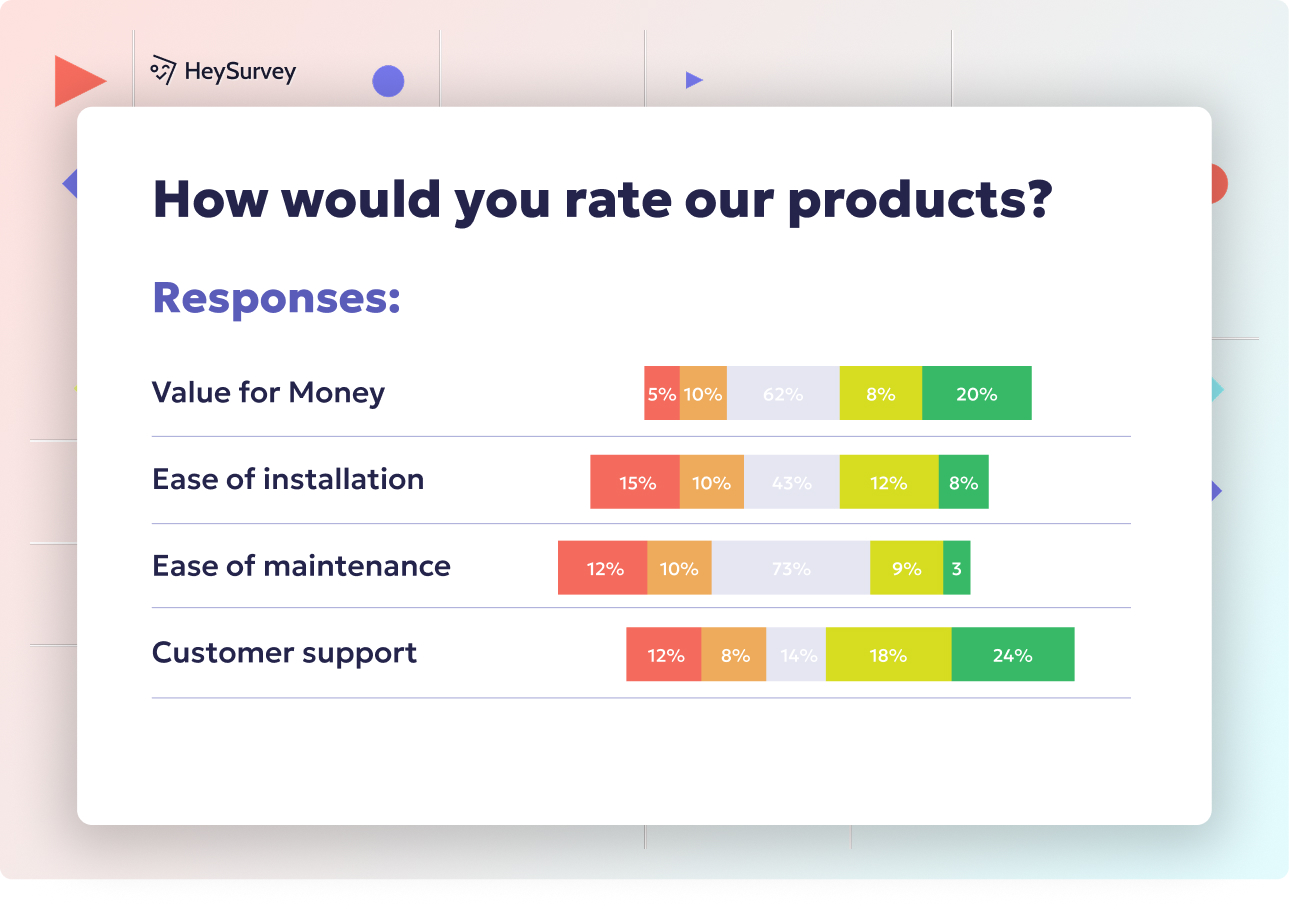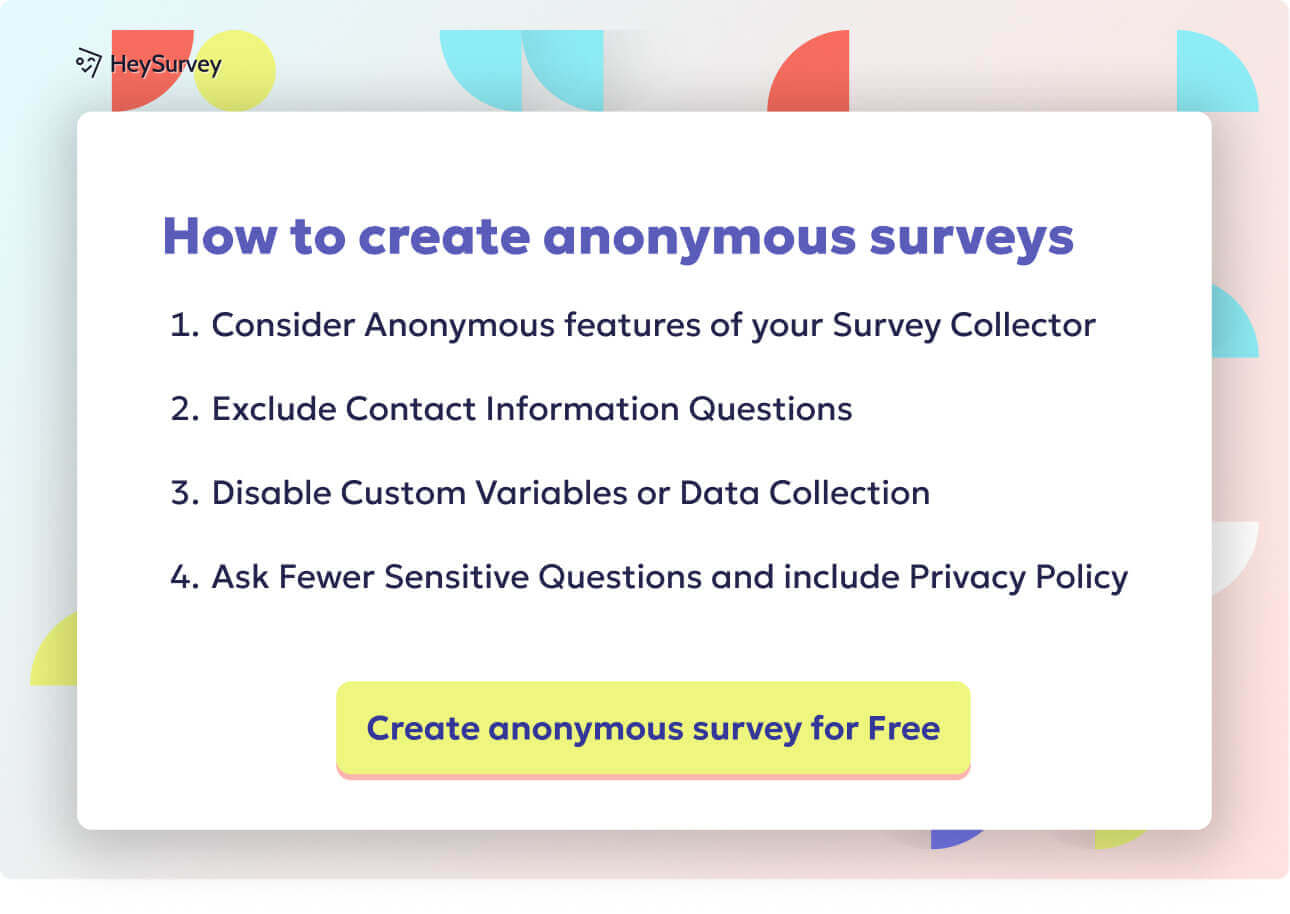32 HR Survey Questions to Boost Engagement & Retention
Discover 30+ expert HR survey questions with sample sets to boost engagement, retention, and performance in your organization today.
In the dynamic world of HR, surveys are more than just forms—they’re powerful catalysts for action. Whether you want to revitalize engagement, fine-tune culture, or hold onto your best talent, the right survey at the right time can spark meaningful change. Let’s dive into how you can master HR survey questions and make every bit of employee feedback count.
Introduction: Why HR Surveys Matter & When to Deploy Them
The Strategic Power of HR Surveys
HR surveys aren’t just about collecting answers; they’re your secret weapon to unlock insights on talent retention, organizational culture, and business success. When you ask the right HR survey questions, you open a dialogue with your employees that goes far beyond the suggestion box. This data-driven approach turns scattered hunches into actionable strategies.
Well-crafted employee feedback surveys help diagnose problems before they brew into bigger issues, support smarter decisions, and boost your employer brand. Pulse surveys—short, frequent check-ins—are great for staying tuned to the everyday rhythm of your workforce. In contrast, annual surveys are your in-depth organizational health check, best used for big-picture strategic planning.
Timing is everything in the world of human resources pulse surveys. If you overwhelm your team with too many questionnaires, response rates plummet. Finding the right cadence for each type of feedback is essential to keep employees engaged and your data reliable. Mastering how to create HR questionnaires that are relevant and well-timed is a skill every HR pro should embrace.
Organizations that conduct employee engagement surveys annually report engagement increases 2.5 times greater than those surveying less frequently. (lsaglobal.com)

How to Create Your Survey with HeySurvey in 3 Easy Steps
Ready to build your survey? Here’s how to get started with HeySurvey, even if you’ve never tried it before.
Step 1: Create a New Survey
- Head to the HeySurvey website and log in or start without an account if you want to explore first.
- Click “Create New Survey” to launch the Survey Editor.
- Choose to start from a Pre-built Template for a fast track, or pick an empty sheet to design from scratch.
- Give your survey an internal name (just for your reference).
Voilà! Your blank canvas (or guided template) is ready to get those questions flowing.
Step 2: Add Questions
- Click “Add Question” either at the top or between questions already in place.
- Select question types that fit your needs: text, multiple choice, scale (like Likert or NPS), dropdowns, or statements.
- Type in your carefully crafted questions and tweak settings like whether a question is required or if respondents can pick multiple answers.
- Need to customize the flow? Use branching to send respondents down different paths depending on their answers — perfect for personalized surveys.
- Add images, descriptions, or format text using simple markdown to make questions clearer and more engaging.
This step turns your ideas into a sleek, interactive survey that’s easy and fun to answer.
Step 3: Publish Your Survey
- Hit the Preview button to see the survey exactly as your respondents will.
- Make any final design tweaks in the Designer Sidebar—adjust colors, fonts, layouts, even add your logo for branding.
- When you’re happy, press Publish to generate your survey link.
- Share it with your team, embed it on a website, or send it via email.
Once published, responses start flowing in and you can track results in HeySurvey’s built-in dashboard.
Bonus Steps to Make Your Survey Stand Out
Apply Your Branding
- Upload your company logo so respondents instantly recognize the survey is legit—no more “who is this from?” hesitation.
- Customize colors and fonts in the Designer Sidebar to match your brand vibe seamlessly.
Define Survey Settings
- Set your survey’s start and end dates to control when it’s live.
- Cap the number of responses if you want to limit sample size.
- Add a friendly redirect URL to send respondents somewhere special after completion (a thank-you page or company site).
- Decide if respondents can view aggregated results after submitting.
Skip Into Branches for a Personalized Journey
- Use branching logic to tailor question paths based on what people answer.
- Create multiple endings with custom messages or images—make surveys feel less robotic and more conversational.
Ready to start? Click the button below to open a survey template and let HeySurvey guide you through every step!
Employee Engagement Surveys
Why & When to Use Engagement Surveys
Engagement surveys are like organization health scans. They measure everything from your people’s motivation levels to their sense of belonging. If you want to know how much your employees care, how motivated they are, or whether they’d sing your praises to their peers, this is where you start.
Running an engagement survey isn’t a once-a-year affair. Most thriving companies use these workplace engagement questionnaires quarterly or at least twice a year. It’s the most reliable way to spot downward trends early and double down on what’s working before it fades.
The magic of employee satisfaction survey questions is in their power to shine a spotlight on silent problems. When you know exactly what boosts or blocks morale, you can take smart action—so your top talent won’t dream of scrolling for new jobs.
5+ Sample Employee Engagement Survey Questions
How likely are you to recommend [Company] as a great place to work?
I feel my work is valued by the organization. (Scale 1–5)
What one change would most improve your day-to-day experience?
Do you see a clear link between your work and the company mission?
In the last week, have you received recognition for good work?
How energized do you feel at work lately?
Talent engagement doesn’t happen by accident. Asking targeted HR survey questions keeps you tuned to employee needs and dreams—so you can keep your organization thriving.
Ensuring anonymity in employee engagement surveys encourages honest feedback, leading to more accurate insights into workplace dynamics. (salary.com)
Onboarding Experience Surveys
Why & When to Use Onboarding Surveys
The first impression lasts. A bumpy or welcoming beginning can shape an employee’s entire journey. Onboarding experience surveys are crucial for diagnosing hiccups and ensuring every newcomer settles in smoothly.
Send new hire survey questions at 30, 60, and 90 days. That cadence keeps you on the pulse of the onboarding process, revealing gaps or shining successes you’d never notice otherwise. When fresh eyes can flag what’s unclear, awkward, or amazing about your onboarding roadmap, better retention and ramp-up speed are just around the corner.
These insights go beyond HR; they help every department fine-tune the welcome mat—making people feel right at home from their first log-in.
5+ Sample Onboarding Survey Questions
How clear were your job responsibilities during your first week?
Rate the usefulness of the onboarding resources provided.
Did you feel welcomed by your team on day one?
What obstacles slowed your productivity in the first month?
What additional support would have improved your onboarding?
Would you recommend our onboarding process to future hires?
A simple first-week employee feedback survey is a hidden gem. It shows new hires their voices matter and guarantees continuous improvement, one fresh perspective at a time.
Training & Development Needs Surveys
Why & When to Use Training & Development Surveys
Investing in growth is the ultimate retention tool. Training needs assessment surveys pinpoint where your team is eager to grow—and where your organization might fall short. You can send these before mapping out your annual learning and development (L&D) roadmap or right before launching new training modules.
Deploying an employee development questionnaire pre-training helps customize sessions for maximum impact. Post-training surveys, on the other hand, reveal if new skills are making it from the classroom to the desk. If you want to spend your L&D budget on what actually matters, let your people guide the way.
These surveys highlight hidden skill gaps and let employees chart their own professional growth, increasing engagement and loyalty in the process.
5+ Sample Training & Development Needs Survey Questions
Which technical skills do you most want to develop this year?
How effective are current training formats (e-learning, workshops, mentoring)?
Do you have time allotted for professional development?
Which certifications would add the most value to your role?
Rate your confidence in applying newly learned skills on the job.
What topics or formats would you like to see added to our learning options?
Wise HR teams use these surveys as their compass—pointing the way to smarter investments and a future-ready workforce.
Conducting a Training Needs Assessment (TNA) can lead to a 22% increase in employee performance by developing targeted training programs. (edstellar.com)
Workplace Culture & Inclusion Surveys
Why & When to Use Culture & Inclusion Surveys
A positive culture is your secret sauce. If your company’s vibe feels right, people dig deep, stay longer, and recommend you loudly. Culture and inclusion surveys let you measure those intangible “feels”—like belonging, safety, and authentic inclusion.
Running a company culture assessment once or twice a year—or after diversity initiatives—helps you track whether you’re walking your talk. These diversity and inclusion survey questions open up candid conversations, exposing hidden barriers so you can bulldoze them out of the way.
Healthy workplace culture doesn’t happen by decree. It grows when employees believe their voices matter and their uniqueness is celebrated.
5+ Sample Workplace Culture & Inclusion Survey Questions
I feel respected by colleagues regardless of background.
Management acts in alignment with stated company values.
I feel comfortable sharing diverse perspectives.
The company takes meaningful action on DEI feedback.
What traditions or practices strengthen our culture?
What could we do to make everyone feel more included?
When you consistently ask about belonging, inclusion, and culture, you shape an organization where everyone feels at home.
Performance Feedback (360°) Surveys
Why & When to Use Performance Feedback Surveys
Multi-rater feedback is a game-changer—especially for leaders and high-potential talent. Performance feedback (360°) surveys pull insights from all angles: managers, peers, direct reports, and sometimes even clients. This holistic view is invaluable for annual performance reviews, promotion decisions, and tailored leadership coaching.
Timing matters here: these peer review questionnaires are best deployed before major reviews or big promotions. Done well, they give a nuanced, fair snapshot of each employee’s strengths and development areas—helping carve clear paths for growth.
A well-run 360 feedback survey template also strengthens trust. Employees know their achievements—and stumbling blocks—are noticed from every side.
5+ Sample Performance Feedback Survey Questions
This individual communicates expectations clearly.
Describe one strength this colleague demonstrates consistently.
Rate this person’s collaboration with cross-functional teams.
What is one behavior that would boost this person’s effectiveness?
How well does this employee handle constructive criticism?
How effectively does this person adapt to changing priorities?
The magic of multi-angle feedback is in the clarity and balance it brings—spotlighting rockstars and up-leveling everyone else.
Exit & Stay Interview Surveys
Why & When to Use Exit & Stay Interview Surveys
What keeps people staying—or sends them packing? The answers shape your entire retention playbook. Exit surveys reveal what made people leave, while stay interview questionnaires surface the perks and motivators that keep top talent thriving.
Run stay interviews at key milestones (anniversaries, promotions) or annually with high performers. Launch exit surveys whenever someone gives notice—ideally before their last week. These insights drive sharper retention strategies, inform manager training, and help close the revolving door for good.
By combining the wisdom of both, you get a high-definition view of what people cherish—and what they run from.
5+ Sample Exit & Stay Interview Survey Questions
What prompted you to look for a new opportunity? (Exit)
What keeps you working at [Company]? (Stay)
What could we have done to prevent your departure?
How would you rate your career growth here?
Would you consider returning to the company in the future?
What’s one thing we could do to make you feel even more valued?
Tackling exit survey questions and stay interview insights head-on is your best bet for a happier, more loyal workforce (and fewer farewell cakes).
Benefits & Compensation Satisfaction Surveys
Why & When to Use Benefits & Compensation Surveys
Compensation isn’t just about paychecks. It’s about benefits, perks, insurance, time off, and everything else that sweetens the employment deal. If you want to keep your rewards competitive and employees appreciative, don’t guess—ask!
Run employee benefits surveys annually or during open-enrollment planning. Find out if your health coverage and bonus programs truly fit your team’s needs, or if something crucial is missing. A good compensation satisfaction questionnaire reveals blind spots that could hurt morale or even scare off top performers.
If you want your "total rewards package" to turn heads, these surveys are your not-so-secret weapon.
5+ Sample Benefits & Compensation Satisfaction Survey Questions
How satisfied are you with your total rewards package?
Which benefit do you value the most?
Is our health coverage meeting your needs?
Rate the transparency of our compensation process.
What additional perks would enhance your well-being?
How fair do you feel your pay is compared to your role and experience?
Asking directly through an employee benefits survey shows your commitment to comfort and fairness in every aspect of work life.
Health, Safety & Well-Being Surveys
Why and When to Use Health, Safety & Well-Being Surveys
A safe, healthy workplace wins trust—and hearts. Regular safety surveys monitor risks and uncover hidden stressors, whether your teams are on-site or remote. Well-being questions gauge the reality of work-life balance and help foster a culture of holistic support.
These surveys shine brightest after new policy rollouts or incident reports, but quarterly temperature checks are a smart baseline. A proactive employee wellness questionnaire spots trouble before it festers and guides investments in new programs or support tools.
From ergonomic setups to stress management, these surveys put well-being center stage—where it belongs.
5+ Sample Health, Safety & Well-Being Survey Questions
I have the tools and equipment necessary to work safely.
The company supports my mental health and stress management.
Do you feel safe reporting safety concerns?
Rate your current work-life balance.
What programs would most improve your well-being?
How aware are you of available health resources at work?
By prioritizing workplace safety surveys and wellness, you send a clear message: people come first, always.
HR Survey Best Practices: Dos and Don’ts
The Dos of HR Surveys
Strategic survey design is more than a checkbox. Nail the basics, and your surveys deliver insights you can actually use.
Set clear objectives for every survey—what do you need to learn?
Always guarantee anonymity to foster candor.
Segment data by team, tenure, or location for sharper insights.
Act on findings swiftly and visibly (closing the feedback loop is magic).
Limit open-ended questions but give space for comments where insight matters.
The Don’ts of HR Surveys
On the other hand, survey mistakes will cost you trust and engagement.
Don’t overload surveys with too many open-ended questions—they’re draining!
Never ignore survey fatigue; less is often more.
Don’t delay follow-up or leave employees in the dark about next steps.
Don’t compromise on confidentiality—one breach wrecks participation for good.
Avoid surveys that are too long, inaccessible on mobile, or unclear in intent.
Pro Tips for Survey Success
Sprinkle in a few extra pro moves to turn your surveys from good to great:
Optimize for mobile devices—people love quick reviews from anywhere.
Experiment with A/B testing subject lines and reminders for better completion rates.
Make sure your surveys are compliant with all relevant regulations (think GDPR and EEOC).
Schedule surveys in advance to make feedback a reliable habit, not a frantic afterthought.
The right HR survey calendar keeps you listening—and acting—at exactly the right moments.
Related Employee Survey Surveys

29 Essential Post Mortem Survey Questions for Project Success
Discover 25+ essential post mortem survey questions to improve projects, boost team morale, and d...

31 Change Readiness Survey Questions to Boost Your Success
Discover 25+ sample change readiness survey questions to assess attitudes, barriers, and confiden...

31 Retreat Survey Questions to Collect Actionable Feedback
Discover 26 essential retreat survey questions to gather actionable feedback before, during, and ...

